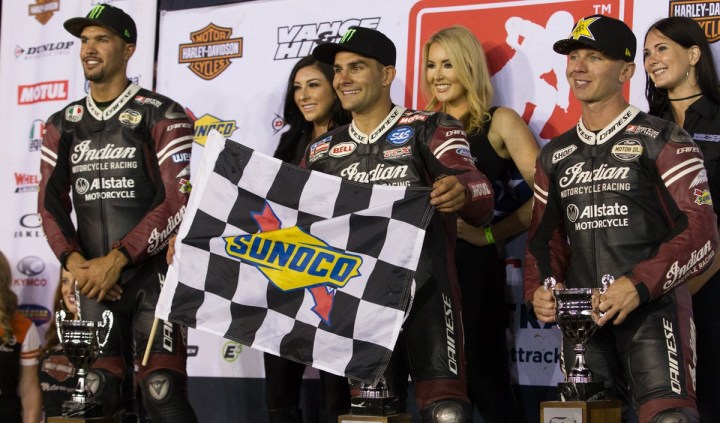
With four races to go in the 2017 AFT season, which doesn’t end until October 7 at the Perris Auto Speedway in Perris, California, this season’s Manufacturer Championship victors have already been named. The AFT announced that American Honda and Indian Motorcycle have clinched the 2017 American Flat Track Singles and Twins titles, respectively.
This is Indian’s first flat-track season with a factory team since the company closed its doors and stopped racing in 1953. Needless to say, the company, which re-started in 2013, is thrilled with the title.
“Securing the Manufacturers’ Championship through 14 races is an unbelievable accomplishment,” said Indian Motorcycle Product Vice President Gary Gray. “To return to professional flat-track racing after more than 60 years away from the sport and win the championship on a brand-new Scout FTR750 race bike is a testament to all the hard work from the entire Indian Motorcycle Racing team.”
The win for American Honda was achieved by Shayna Texter, Brandon Price, Parker Norris, and Tanner Dean, sponsored separately, with each riding a Honda CRF450R.
“We’re very pleased that Honda has earned the 2017 AFT Singles Manufacturers’ title with four rounds remaining,” said American Honda Powersports Marketing Senior Manager Mike Snyder. ” With seven of the top 10 riders in the current points standings being Honda-mounted, it’s clear that the CRF450R is the bike of choice for flat-track racing.”
There are two classes of AFT racing: Singles and Twins. The designations refer to the number of cylinders in the motorcycles allowed to race in each class. There are loads of other requirements, but one of the most basic is Singles class bikes can’t have engines larger than 500cc and Twins are restricted to 750cc or less.
American Flat Track racing takes place on half-mile and mile tracks. For 2017 the AFT season includes 18 races, four of which are on TT tracks. “TT” stands for “tourist trophy,” and it’s a term that goes back to the International Isle of Man TT inaugural race in 1907. The difference between a TT and a non-TT race has nothing to do with tourists, it just means the race course has jumps. So it’s a flat track with jumps.

The Manufacturers Championship is awarded based on the performance of riders on bikes made by that company. They can be manufacturer-sponsored teams, but that’s not required. Whether there are factory-sponsored teams or not, if the riders of a particular motorcycle brand score the highest number of points, that manufacturer wins the title.
For example, the Indian Motorcycle team of Jared Mees, Bryan Smith, and Brad Baker is a manufacturer’s team also backed by Allstate Insurance. The only other factory-sponsored team in the Twins class is the Harley-Davidson team.
Mees, Smith, and Baker have been dominating the Twins class this season, earning a tradition-loaded label, the “Wrecking Crew.” There’s confusion about exactly when the term was first used, although it goes back at least to a Harley-Davidson team in the 1920s that consisted of Fred Ludlow, Ralph Hepburn, Otto Walker, Red Parkhurst and Ray Weishaar, also known as “The Hog Boys” because they carried the team mascot, a small pig, on victory laps. The post-World War II Indian Wrecking Crew of the 1940s and 1950s was the era when Ernie Beckman, Bill Tuman, and Bobby Hill dominated the tracks.



